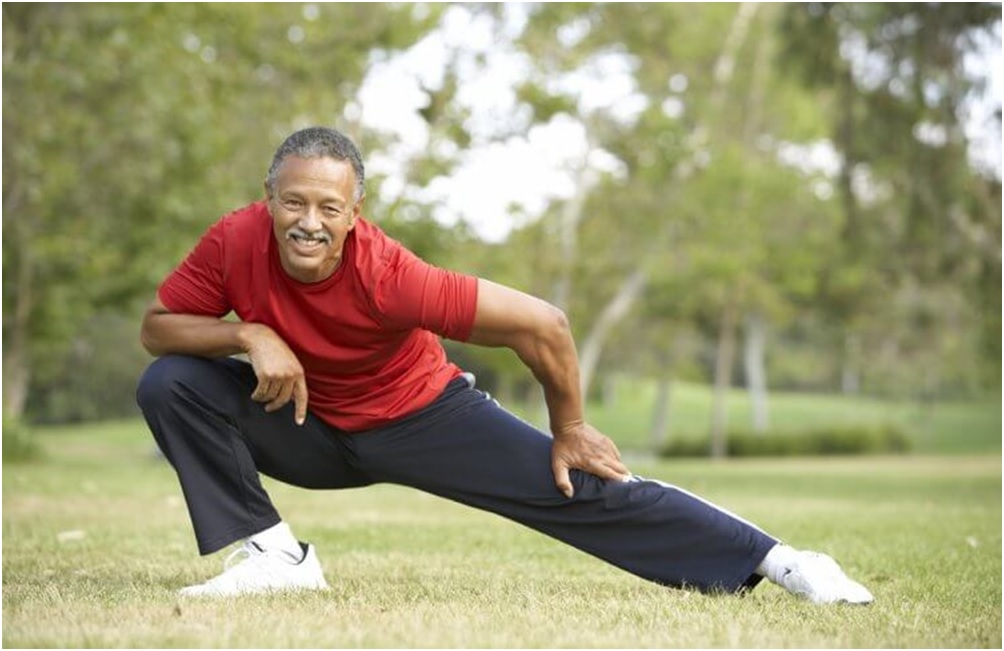Enjoy great health benefits without the need for special equipment
By Edmund O. Lawler
When she talks to her patients about exercise, Johns Hopkins geriatrician Dr. Alicia Arbaje encounters resistance about two-thirds of the time.
“I’m too old, I’m too sick, I’m in too much pain,” Arbaje says are the reasons most frequently given by patients for not wanting to exercise. Research, she counters, points to overwhelming evidence that regular exercise confers a wealth of health benefits.
Another reason she hears for not exercising: “I don’t have the time.” Arbaje parries that one as well by explaining that a form of exercise that uses nothing more than a person’s own body weight can be done just about anywhere and just about any time.
Unlike using free weights or machine weights, body-weight exercise relies on a person’s own weight to provide resistance and boost muscle strength and flexibility.
Arbaje, associate professor of medicine at the Johns Hopkins University School of Medicine in Baltimore, says yoga-like body-weight exercise, also known as calisthenics, makes things easier for people who don’t have easy access to a gym or don’t have a fancy home gym with specialized equipment.
Building Strength, Boosting the Heart Rate
“It’s important for people over 50 to focus on strength, cardiovascular training and flexibility,” Arbaje says. “Body-weight training can incorporate all of those, particularly the strength and cardio training because it gets the heart rate up. Anything that gets people moving is important.”
People launching an exercise program, especially those who’ve been sedentary, will initially experience some muscle soreness caused by inflammation, Arbaje says. “But your body begins to adjust,” she adds. And while chronic inflammation is associated with many of the leading illnesses, such as heart disease, diabetes, cancer and arthritis, “regular exercise is anti-inflammatory,” Arbaje says.
Before starting a body-weight exercise program, Arbaje recommends people have a conversation with their doctor to determine what they can safely handle. She also recommends someone new to body-weight exercise consult at least initially with a personal trainer. “You can get injured with incorrect form and not being aligned properly, which puts too much strain on certain parts of the body,” she says.
Scales Tip in Favor of Using Body Weight to Exercise
The benefits of using your body weight to exercise, however, far outweigh the risks.
Cognitive function, Arbaje says, improves with any form of exercise. “We’re not exactly sure of the direct link, but it’s most likely related to improved circulation in the brain. Anything that is good for your heart is good for your brain.”
Body-weight exercise done with a partner or with a group in a class has socialization benefits, too. And weight-bearing exercise can improve bone health and help prevent osteoporosis.
Sue Quigley, a 60-year-old banker who lives in the western suburbs of Chicago, had been an avid walker. It was her only form of exercise. But after a bone scan detected osteoporosis in her lower spine, she began exercising with hand weights to maintain and build bone strength.
She only lifted the weights sporadically, however, and realized her exercise routine was not improving her bone health. At the start of this year, Quigley bought a set of instructional DVDs based on Classical Stretch, the long-running public TV fitness show hosted by Miranda Esmonde-White. It regularly incorporates body weight exercise.
Quigley now religiously does the weight-free, full-body Classical Stretch workout five days a week in her home. She believes the 30-minute workout has improved her bone and muscle strength. “I’m feeling really good,” she says. “I now have some muscle definition in my upper arms, which I didn’t have when I was using my hand weights.”
Mimicking the Movements of Everyday Life
Kinesiologist Angela Russell says body-weight exercises often mimic the multidimensional movements of daily activities, such as walking up stairs, shopping or gardening. At Auburn University at Montgomery, in Alabama, where she is an assistant professor, Russell teaches a lunchtime body-weight exercise class for adults that emphasizes those types of everyday movements.
“Body-weight exercises allow you to maintain a basic level of strength to help you be more functional in everyday life and remain independent longer,” she says. Among the exercises in her classes: crawling, squatting, calf-raises, stand-up pushups against a wall or simply sitting on an exercise ball to enhance core strength.
When people think about strength training, Russell says, weightlifting usually comes first to mind. “But you can load too much weight on the bar and suffer an injury,” she says. “With body-weight training, you eliminate that risk because you’re not guessing how much weight to put on a bar.”
A person’s muscles don’t make the distinction between an exercise done by someone controlling his or her own body weight versus one done with a free weight or a machine weight, Russell says. “For example, similar changes in muscle strength are produced by the pushup, a form of body-weight exercise, versus a bench press, which is done with free or machine weights,” she says.
Consider Your Limitations
Russell does caution, however, that overweight or obese people must be careful. Their extra pounds can put unusual strains on their bones and joints. And even older adults in good physical condition beginning a body-weight training regimen have less flexibility and muscle strength (as well as a higher percentage of body fat) than when they were younger.
Recovery time from a workout will tend to take longer when you’re older, too,, Russell says. “Younger people tend to take a day of rest between workouts. An older adult may need to take two recovery days,” she notes.
Despite a slight injury risk and longer recovery times faced by adults doing body-weight exercising, its convenience is hard to beat. Says Russell: “You can exercise with your own body weight anywhere. All you need is yourself.”
© Next Avenue – 2018. All rights reserved.
